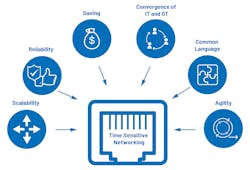Time-Sensitive Networking: Five Ways the IEEE Standards Will Advance Industry 4.0
Across the world, I meet with customers investing hundreds of thousands, even millions, into making the promise of Industry 4.0 a reality. This new paradigm of ubiquitous connectivity is inspiring manufacturers, from the largest automation OEMs to emerging businesses. They see the potential to make their businesses more productive, efficient, adaptable, and profitable for the bottom line and ultimately for their employees, stakeholders, and customers.
Industry 4.0 promises unprecedented levels of flexibility that translate into agile production by allowing manufacturers to adapt to seasonal or changing customer needs, for example. We will be able to improve uptime (which controls overhead and maintenance costs), reduce resource time and involvement, and boost business and customer confidence. These are just a few examples of potentially industry-changing outcomes we can anticipate as a result of the fourth industrial revolution.
Underscoring these massive opportunities is the need to acquire, communicate, and analyze data. Data, and most importantly the insights extracted from that data, is the currency by which all of these improvements can be obtained. However, in most factories today, data lives in siloes where it sits isolated and inaccessible, and therefore, unactionable. For years, manufacturers have tried to solve for this, but working in siloes has stunted these projects.
Enter Time-Sensitive Networking (TSN), a set of IEEE Ethernet standards that is foundational for meeting the many powerful outcomes of Industry 4.0. With TSN, all data across the factory—from the floor to servers, front office, and everywhere in between—can coexist and communicate. Because TSN is the first step to breaking down existing data siloes that hinder industrial communications, it can enable ubiquitous access to precious, decision-making data.
TSN is the jumping off point for helping industrial organizations achieve the promise of Industry 4.0 in five key ways, all rooted in making data more accessible:
- Creates a common language. By creating a uniform understanding of time synchronization—and uniform treatment of all data packets and information—TSN allows data to speak a common language. While equipment interoperability challenges will still exist, manufacturers will be able to derive more value from their data that can now all coexist in the same Ethernet path.
- Enables scalability and agility. TSN can help Ethernet manage a range of transmission rates for data sends so that there is enough bandwidth for data throughput at all priority levels. Ultimately, manufacturers can add or reduce capacity more easily and adapt to changing customer priorities and needs.
- Supports more reliable automation. TSN supports the real-time, deterministic data crucial for accuracy and precision. If the timing of a data point (for example, a signal) is delayed or off in any way, a machine may not respond properly and cause downstream impacts that decrease productivity and result in lost revenue. Consider, for example, the precision required for a robot to work alongside a human; if the robot’s movements are off by even a fraction of an inch, worker safety can be jeopardized. TSN facilitates instantaneous communication applications like this and many more to improve safety and quality.
- Helps close the divide between information technology (IT) and operating technology (OT) specialists. By providing a common set of tools, TSN supports the often distinct and competing goals of IT and OT teams. It presents a common framework, a shared language, that supports collaboration. Additionally, we’re seeing many OT specialists near retirement age, meaning they’ll take their historical expertise of today’s field buses to retirement with them. TSN has the potential to solve for these future skills gaps by providing a common framework that enables IT specialists to support industrial Ethernet. This saves resources and can increase productivity.
- Allows companies to allocate their R&D spend elsewhere. Since TSN solves for bandwidth constraints, companies no longer need to build new bandwidth allocations when they try to scale up or add new capacity. We’ve seen companies invest tens of millions in infrastructure that becomes obsolete or ineffective just a decade later. TSN dramatically reduces the need for rebuilding and thus creates opportunity for investment in technologies that support greater automation. It frees up capital for reinvestment in upskilling employees by training them to manage and operate complex robotic systems, for example.
There is no doubt that TSN standards are a crucial, foundational building block for the promise of Industry 4.0 and the many applications it will transform—ushering in the next generation of technology to revolutionize how manufacturers work and operate. Yet it’s just one piece of a broader ecosystem we’re building to bring the fourth industrial revolution to life. That requires software, middleware, advanced silicon components, brilliant inventors and engineers, dedicated technicians and operators, education, and time. But my colleagues at Analog Devices and across the industry believe in the incredible potential of these emerging technologies and, like our customers and partners, feel inspired by the nearly endless opportunity.

